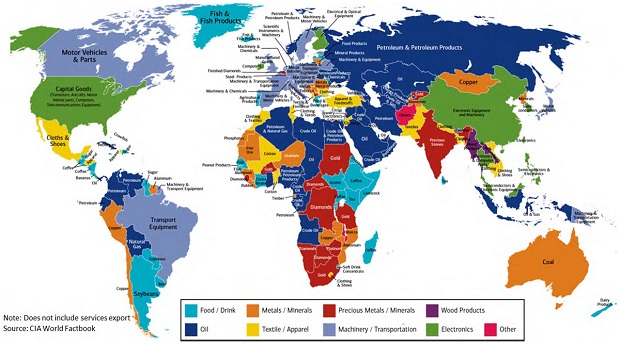News
Which are Africa’s biggest exports?

From gold and diamonds to soft drink concentrates, the following map shows the diverse range of products exported from African economies – while also highlighting an overall reliance on commodities.
The map, shared by the Bank of America Merrill Lynch, shows the situation around the world, including across Africa. Although it does not include services, it offers a fascinating insight into exports across the continent, from Algeria to Zimbabwe.
Released as part of their Transforming World Atlas, the report outlines the risk posed by a volatile global commodities market. With so many African economies dependent on exports of oil, metals and minerals, the impact of the commodities slump is being felt across the continent.
The map uses 2014 data from the CIA World Factbook.
Image: Bank of America Merrill Lynch
An African snapshot
The frequency of dark blue and orange across Africa highlights the importance of commodities to the continent’s economies. From Algerian petroleum and natural gas in the north, to Zambian copper in the south, these exports dominate many national economies.
Consider Nigeria, whose biggest export is petroleum and petroleum products: according to OPEC, the oil and gas sector accounts for over a third of gross domestic product.
As Professor Calestous Juma makes clear: “The current slump in world commodity prices is forcing Africa to rethink its traditional dependence on raw material exports.” However, he believes this presents an opportunity for commodity-dependent nations to shift from extractive to learning economies.
It’s not just oil and gas
But, the map also makes clear the range of exports in Africa. In the east, exports of food and drink are very important, including coffee, grains and livestock.
Textiles and clothing is also an important industry. In Morocco, Tunisia and Lesotho, clothing, shoes and textiles are the biggest exports. Equally, cotton is vital to the economies of Mali, Togo and Benin.
In the south and central regions, precious metals and minerals are the biggest exports. This includes gold in Tanzania and South Africa, diamonds in Namibia and the Democratic Republic of the Congo and platinum in Zimbabwe.
What is the world exporting?
The map highlights a number of global patterns, notably the importance of oil exports to many economies. Dark blue shading represents countries where oil is the biggest export and shows the importance of oil not just in the Middle East, but across Asia and Africa and South America.
Other commodities, including precious metals and minerals, also play a significant role in the global economy. Across much of Asia and Africa, large numbers of countries shaded in red and orange indicate the importance of exports such as gold, iron ore, and coal to these nations. Interestingly, and perhaps unexpectedly, India’s biggest export is precious stones.
Conversely, European exports are focused on machinery and transportation.
Electronics dominate in both China and the USA, while food and drink and textiles top the bill in a number of countries.
As the World Economic Forum’s E15 Initiative argues, there has been a “significant slowdown” in global trade since the 2008 financial crisis. An effective global trade and investment system is key to boosting economic growth and meeting global challenges.
Understanding the national and international picture is central to ensuring the effectiveness of this system. The global export situation is just one part of developing this understanding and improving efficiency, as well as understanding the risks faced by countries around the world.





